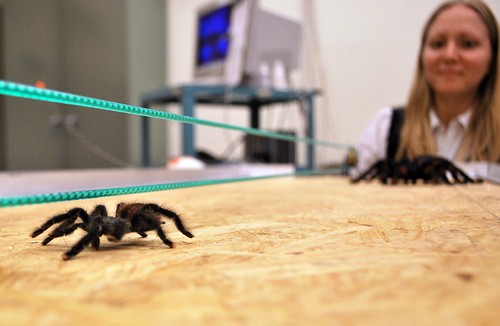Going to the beach, passing a piercing parlor or watching a Britney Spears music video causes little distress for most. For sufferers of omphalophobia, or the fear of belly buttons, these incidents could cause serious reactions.
A phobia is a severe and illogical fear of an object or situation. About 8.7 percent of American adults have at least one phobia, according to a 2005 study from the National Institute of Mental Health.
“”To be a phobia it has to be something that doesn’t pose a threat,”” said Sarah Burger, graduate student researcher in the Anxiety Research Group and clinical psychology doctoral candidate. “”If you’re afraid of something actually dangerous, that’s called rational thinking.””
Many people have strong fears or dislikes that may not technically be phobias.
“”OK, well, I really don’t like it when people rub carpet,”” said nutrition freshman Kelli Kostizak. “”It makes my stomach knot up.””
Undecided freshman Sarah Brody said she knew a person with a “”weird”” fear.
“”I had someone who said they’re really afraid of moss,”” Brody said.
Unlike general, everyday fears, phobias can cause distress through anticipation, by either thinking about a situation or coming into contact with a certain object.
“”The phobia is kind of where the fear has reinforced itself,”” said Michael Strangstalien, mental health clinician for Counseling and Psychological Services. “”It doesn’t even need to necessarily happen.””
Burger’s research compares how those with phobias predict they will react upon encountering their phobia with their actual reaction.
Burger asked participants to predict their reaction to encountering the object of their phobia in different situations such as reading about it, seeing it in a movie or finding it in their room.
“”Now we’re actually having them test their predictions,”” Burger said.
People with arachnophobia are monitored while being approached by a virtual tarantula, a robotic tarantula and a living tarantula. Some reactions to the object of the phobia include panic attacks, increased heart rate and nausea, according to Burger.
Strangstalien described a phobia as a “”psychological jail”” in which those affected will rearrange their lives to avoid all contact.
Phobias range from the fear of snakes, ophidiophobia, to the more obscure gnosiophobia, which is the fear of knowledge.
“”My favorite phobia is ponophobia,”” Strangstalien said. “”Ponophobia is the fear of hard work.””
Strangstalien said it is common to disregard unusual phobias as unreasonable, which can lead to the stigmatization of those who suffer from them.
“”(People) think some of these phobias are crazy,”” Strangstalien said. “”To the person who is terrified of having to work, that’s real in their mind.””
The most common phobias at the UA are the fear of blood injections and social phobias, according to Strangstalien.
“”I have both of those,”” Brody said. “”I hate when I get my blood drawn, and I get shaky when I talk publicly.””
Many people suffer from phobias regarding public speaking or social situations.
“”Usually people will actually get visceral, somatic symptoms,”” Strangstalien said. “”They’ll get physically sick.””
Strangstalien said he does not treat a large number of phobic students at the UA.
“”These things get noticed in high school or earlier years,”” Strangstalien said. “”It’s been treated.””
For those whose phobias dictate their lives, professional help is available.
“”It’s not enough to say ‘It’s all in your head,'”” Strangstalien said.
Scientists still do not know exactly what causes phobias. But Burger said many theories predict phobias stem from people having an association of the object of their phobia with “”something that actually is scary.””
Many people cannot remember the specific instance that started their phobia.
“”A lot of people say, ‘I don’t know. I’ve been afraid as long as I can remember,'”” Burger said.
Some theories suggest people learn these associations as infants before their memories are fully formed.
The biological preparedness theory attempts to explain why humans are more likely to be afraid of spiders than string. Phobias may have acted as a natural preservation mechanism in the past.
“”We’re sort of keyed up to be fearful,”” Burger said.









